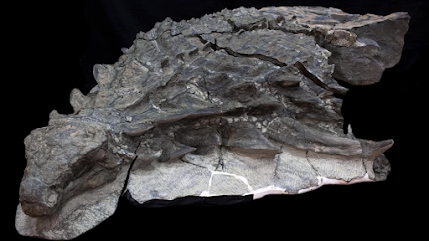Fossil Friday #7 - Borealopelta
A lot of the time, palaeontologists have to work with small fragmental puzzles in order to build a bigger picture of an organism. Many species of ancient life have been described based on minimal evidence, such as a few teeth or a fragmented femur. This is the case with most findings, as large impressive specimens that are mostly seen in museums are unfortunately the minority. This only makes larger fossils of complete or near-complete specimens all the more exciting. Examples of these larger near-complete specimens include some of the most iconic museum specimens in the world, such as Sue the Tyrannosaurus rex or Dippy the Diplodocus carnegii. There is no doubt that these, amongst others, are some of the most impressive specimens in the world and have inspired millions of people worldwide. In my opinion, however, one of the most impressive near-complete dinosaur specimens in the world was named in 2017 and belongs to Borealopelta markmitchelli.
The first, and to date, only Borealopelta was discovered in 2011 by Shawn Funk, a miner in Alberta, Canada, who came across the specimen by accident, as is the case with many large significant finds. After only two days of the initial discovery, Donald Henderson and Darren Tanke from the Royal Tyrrell Museum of Palaeontology were invited to the mine to examine the specimen. Before the significance of the find was fully realised, Henderson identified it as an Ankylosaurid, which in itself seemed out of place, as the only previous fossils in this area had belonged to marine reptiles, suggesting this Borealopelta may have been swept out to sea after its death, which may have been part of the reason why it had preserved so well. It took 14 days for a team from the museum to fully excavate the specimen, and then a further 6 years to carefully prepare the fossil. Rather wholesomely, Borealopelta markmitchelli was named after its preparator, Mark Mitchell, paying homage to the extremely skilled and precise work that was required to get this incredible specimen ready for research and display (Brown et al, 2017; Greshko, 2021)
Brown, C.M. et al. (2017) “An exceptionally preserved three-dimensional armoured dinosaur reveals insights into colouration and Cretaceous predator-prey dynamics,” Current Biology, 27(16). Available at: https://doi.org/10.1016/j.cub.2017.06.071.
Brown, C.M. et al. (2020) “Dietary palaeoecology of an early cretaceous armoured dinosaur (Ornithischia; Nodosauridae) based on floral analysis of stomach contents,” Royal Society Open Science, 7(6), p. 200305. Available at: https://doi.org/10.1098/rsos.200305.
Greshko, M. (2021) This is the best dinosaur fossil of its kind ever found, Magazine. National Geographic. Available at: https://www.nationalgeographic.com/magazine/article/dinosaur-nodosaur-fossil-discovery (Accessed: March 9, 2023).



Comments
Post a Comment